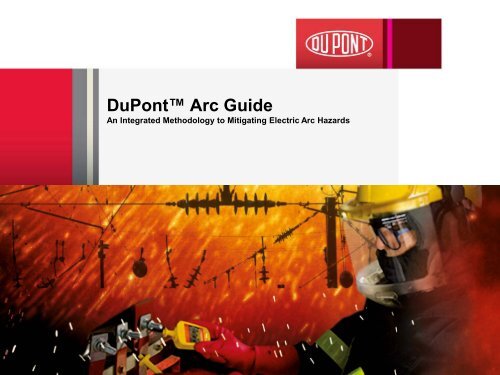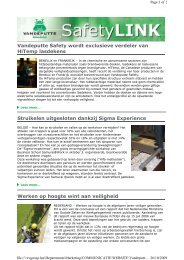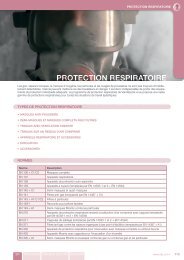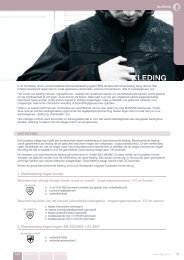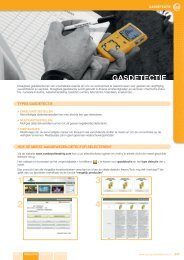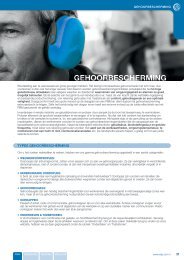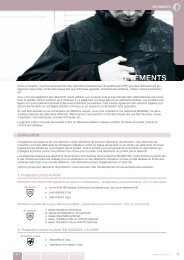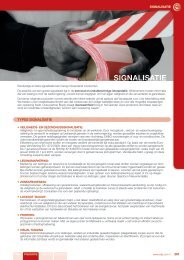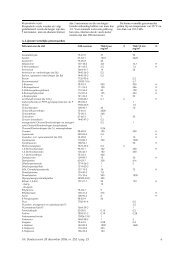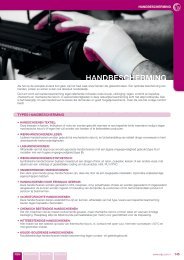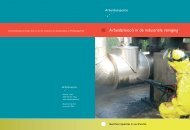DuPont Arc Guide
DuPont™ Arc Guide - Vandeputte
DuPont™ Arc Guide - Vandeputte
- No tags were found...
Create successful ePaper yourself
Turn your PDF publications into a flip-book with our unique Google optimized e-Paper software.
<strong>DuPont</strong> <strong>Arc</strong> <strong>Guide</strong><br />
An Integrated Methodology to Mitigating Electric <strong>Arc</strong> Hazards
Agenda<br />
1. Introduction<br />
2. <strong>Arc</strong> Hazard Risk Methodology<br />
- Predict<br />
- Prevent<br />
- Protect<br />
- Publish<br />
Predict<br />
Publish<br />
Prevent<br />
Protect<br />
3. Wrap-up and closure<br />
2
<strong>DuPont</strong> Safety Culture – History<br />
Safety has become part of our DNA<br />
Powder mill operation began<br />
in 1802.<br />
Safety statistics began in 1912.<br />
Off-the-job safety program<br />
began in the 1950s.<br />
1800 1850 1900 1950 2000<br />
Belief that all injuries are preventable<br />
developed in the 1940s.<br />
First safety rules established in 1811.<br />
“Safety is a line management responsibility.<br />
… No employee may enter a new or rebuilt mill<br />
until a member of top management has<br />
personally operated it.”<br />
– E. I. du Pont<br />
“Goal is Zero”<br />
established in 1990s.<br />
3
<strong>DuPont</strong> Aims to Help Safety Managers with the Challenges<br />
Faced by Electric <strong>Arc</strong><br />
INDUSTRY CHALLENGES...<br />
• Assess Hazard severity<br />
• Comply with EU Directives<br />
• Implementation of risk reduction & protection measures<br />
• Selection of Appropriate PPE for residual risks<br />
<strong>DuPont</strong><br />
Engineering<br />
Research &<br />
Technology<br />
<strong>DuPont</strong> Protection<br />
Technologies-<br />
Makers of Nomex®<br />
Expert<br />
External<br />
Consultants<br />
4
Our Methodology for Approaching <strong>Arc</strong> Risk Hazards<br />
Re-evaluate<br />
YES<br />
Predict<br />
Severity<br />
Results<br />
Can we apply<br />
further<br />
prevention<br />
techniques?<br />
START<br />
• Calculate<br />
• Validate<br />
Predict<br />
Prevent<br />
• Risk<br />
Reduction<br />
• Hierarchy of<br />
risk controls<br />
NO<br />
Publish<br />
Results &<br />
Training<br />
• Information<br />
• Training<br />
• Labelling<br />
Publish<br />
Protect<br />
Apply<br />
Protection<br />
Measures<br />
• Residual risk<br />
• Optimum<br />
solutions<br />
Residual<br />
Risk<br />
5
Agenda<br />
1. Introduction<br />
2. <strong>Arc</strong> Hazard Risk Methodology<br />
- Predict<br />
- Prevent<br />
- Protect<br />
- Publish<br />
Predict<br />
Publish<br />
Prevent<br />
Protect<br />
3. Wrap-up and closure<br />
6
<strong>Arc</strong> Flash Hazard Assessment<br />
How do we measure the extent of the hazard?<br />
Calculate the „Incident Energy“, which defines the severity of the arc flash at a<br />
certain distance<br />
Measured in kJ/m 2 , J/cm 2 , or cal/cm 2<br />
1.2 cal/cm 2 applied to skin for 1 second: the threshold for the onset of second<br />
degree burns<br />
Governs the arc flash boundary<br />
-Based on 1584-2002 IEEE <strong>Guide</strong> for Performing <strong>Arc</strong> Flash Hazard Calculations-<br />
7
What affects <strong>Arc</strong> Energy Level?<br />
Utility or HV Supply<br />
11kV<br />
400V<br />
Transformer<br />
AMOUNT OF<br />
CURRENT<br />
DURATION OF<br />
CURRENT<br />
1 2 3 4<br />
Protective device type<br />
or characteristic?<br />
Panel to be worked upon<br />
Fault Level in kA?<br />
8
Incident Energy Exposure Level<br />
Based on:<br />
Equipment type<br />
Working<br />
Distance<br />
Working distance<br />
9
Flash Protection Boundary<br />
Flash Protection Boundary<br />
“The boundary within<br />
which a person could<br />
receive a second<br />
degree burn from an<br />
arc flash incident.“<br />
Definition IEEE1584<br />
10
Effect of distance on Incident Energy<br />
11
Online <strong>DuPont</strong> <strong>Arc</strong>-<strong>Guide</strong><br />
12
Sample Calculation<br />
Typical European Medium-sized manufacturing company<br />
13
Full calculation<br />
Projection 14
Full calculation<br />
Projection 15
Full calculation<br />
16
Full calculation<br />
Select the number of wires in the cable.<br />
Choose between copper and aluminum cables<br />
Choose the cross-section of the cable<br />
Select the number of parallel cables.<br />
Enter the cable length.<br />
17
Full<br />
Calculation<br />
Projection 18
Full calculation<br />
Progose<br />
Projection 19
Full calculation<br />
Projection 20
Calculation<br />
Projection 21
Calculation<br />
Projection 22
Full calculation<br />
Prevention 23
First Calculation:<br />
Second Calculation: Replacement of NH fuse by ultra-rapid fuse<br />
Prevention 24
Prevent: Risk Elimination – Safe Systems of work<br />
Human Factors<br />
The importance of Human Factors<br />
Awareness of the hazard<br />
Training and competence assessment<br />
Electrical duty holder/champion<br />
Processes<br />
Written procedures<br />
Based upon risk assessment<br />
Clearly defined, written instructions<br />
Clear responsibilities<br />
Contractor competence<br />
Prevent<br />
25
Protecting against residual risk<br />
Residual risk after all mitigation measures in place<br />
Personal protective equipment<br />
The European legislative framework<br />
Body protection<br />
Layering<br />
Everyday workwear<br />
Additional protection<br />
Hand face and eye<br />
26
Ensuring Fit-for Purpose Garments for Your Situation<br />
<strong>Arc</strong> Rating<br />
Body Protection<br />
ATPV > 4 cal/cm2<br />
Box Test Class 1<br />
ATPV > 8 cal/cm2<br />
Box Test Class 1<br />
Long Sleeved<br />
Business Shirt<br />
Long Sleeved<br />
Polo Shirt<br />
Jacket<br />
Trousers Coverall Coat<br />
ATPV > 12 cal/cm2<br />
Box Test Class 1<br />
ATPV > 25 cal/cm2<br />
Box Test Class 2<br />
ATPV > 40 cal/cm2<br />
Box Test Class 2<br />
Weather Jacket & Trouser<br />
27
Layering with solutions made from NOMEX® fabrics<br />
Lightweight comfortable layering offering relevant level of protection<br />
Ensure worker is not restricted from cumbersome clothing<br />
Possible Nomex® multi-layer systems include<br />
• Underwear<br />
• Shirts/jackets/trousers/coveralls<br />
• Polo Shirts<br />
• Sweatshirts<br />
• Multi-layer jackets and trousers<br />
• High Visibility<br />
• Foul weather gear<br />
• Multi- layer systems for short duration wear<br />
for high level incident energy risks<br />
Hand Protection<br />
Eye/Face/Head Protection<br />
Source: Centurion<br />
Source: J & K Ross<br />
Source:J + K Ross<br />
Source: Dehn
Publishing of results<br />
Risk Assessment Report Forms<br />
Training<br />
Labelling of switchgear and Control Panels<br />
Publish<br />
Results &<br />
Training<br />
29
Publishing of results<br />
30
Agenda<br />
1. Introduction<br />
2. <strong>Arc</strong> Hazard Risk Methodology<br />
- Predict<br />
- Prevent<br />
- Protect<br />
- Publish<br />
Predict<br />
Publish<br />
Prevent<br />
Protect<br />
3. Wrap-up and closure<br />
31
For Additional Info:<br />
www.arcguide.dupont.com<br />
Public website<br />
Full application & services<br />
Risk Assessment:<br />
•Predict<br />
•Prevent<br />
•Protect<br />
•Publish<br />
Access to experts


